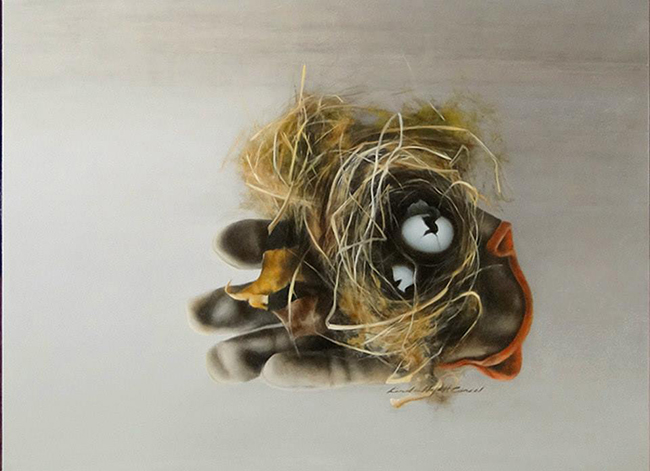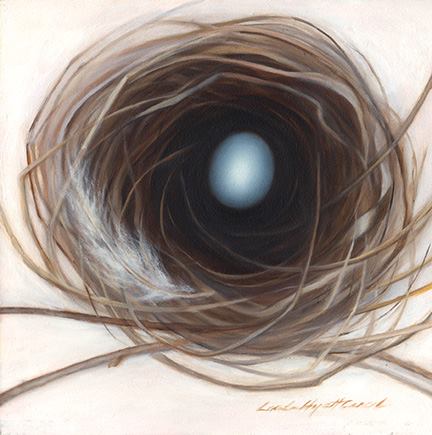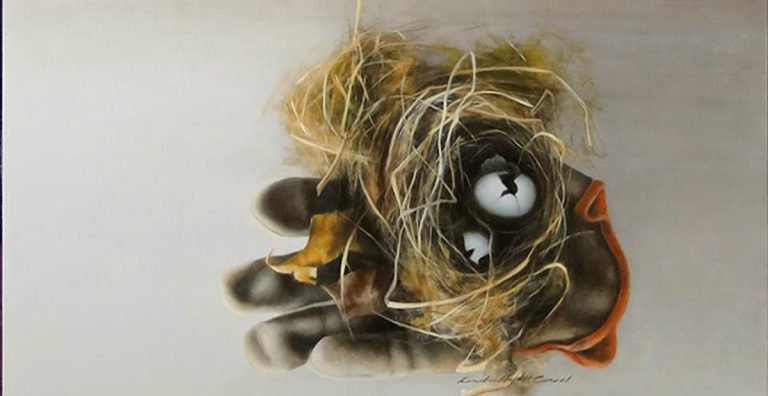Linda Cancel was born in 1959 in the quiet town of Moscow, Idaho. One of her first memories—watching fireworks shimmer over the Snake River as a toddler—left a lasting impression. From that moment on, she seemed drawn to light and the way it lingers. Raised in the Pacific Northwest, she grew up surrounded by mist, pine, rivers, and snow—an environment that shaped her sense of mood and space. At twelve, she began private oil painting lessons with artist William F. Pogue. He introduced her to story-driven painting and the traditions of the Golden Age of Illustration. This early exposure influenced not only how she painted, but what she chose to say through her work.
She later studied Visual Merchandising and Display Design at Spokane Falls Community College. There, she deepened her understanding of how color and composition could guide the eye and shape experience. That foundation, along with her lifelong curiosity in geology, anthropology, and storytelling, shaped a thoughtful and layered style. After decades of living and working on the East Coast—where her work found gallery representation—Cancel returned to the West in 2013, reconnecting with the land that inspired her beginnings.
The Work
There’s a softness to Linda Cancel’s work—but it’s not passive. It’s attentive. She captures the kinds of moments most of us overlook, and she doesn’t embellish. Instead, she presents them quietly, letting the stillness do the talking.

In A Mother’s Glove, Cancel places a bird’s nest inside an old glove. The nest holds cracked eggs, mid-hatch. The glove is worn and open, almost offering the nest. It feels like a fragment of a story—a moment remembered rather than staged. The textures are earthy: straw, leather, broken shell. The glove could represent protection, memory, loss, or all three at once. What’s striking is how intimate it feels, like finding something forgotten in a drawer, still full of meaning. Cancel doesn’t push the metaphor. She lets it sit there and breathe.

Light at the End of the Tunnel is more abstract, but just as evocative. A single blue-tinted egg rests at the center of a tightly wound nest. The background is pale and soft, almost luminous. There’s a pull to the image—your eye naturally moves inward, toward that small point of focus. It could be about life beginning, or just the potential of it. Cancel leaves room for interpretation. The egg seems to hold light, not just reflect it. And the whole composition feels like a meditation on stillness and waiting.

With Rhapsody in Rose Quartz and Serenity, Cancel shifts away from the object-based focus of the other two pieces. This one is landscape—trees dusted in snow, reflected perfectly in still water. It’s quiet and cool, almost dreamlike. The palette is muted: grays, soft violets, faint greens. The scene is peaceful, but it doesn’t feel empty. It feels like something is being remembered. The title suggests music, and you can sense the rhythm in the way the trees stand, the way the reflection stretches downward. Nothing in the scene moves, but it hums.
Across all three paintings, Cancel invites the viewer to slow down. She isn’t trying to dazzle or provoke. Her work sits gently in its place, waiting to be noticed. There’s a balance between form and feeling. Her compositions often revolve around central shapes—an egg, a glove, an island—pulling the eye inward. Her light is soft but deliberate. It shapes without dominating.
Linda Cancel’s art feels like a kind of listening. It listens to land, to memory, to moments that don’t usually get center stage. These aren’t grand declarations. They’re quiet, concentrated images that stay with you. They ask you to look again—and to sit with what you find.

